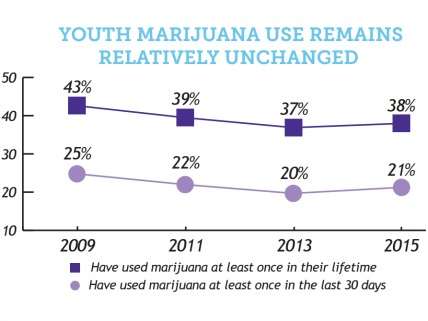Colorado Survey Finds Adolescent Marijuana Use Did Not Rise After Legalization
The results contrast with those from the National Survey on Drug Use and Health.

The Colorado Department of Public Health and Environment reports that the state's latest survey of teenagers "shows marijuana use has not increased since legalization." In 2015 the Healthy Kids Colorado Survey (HKCS), which is conducted every two years, found that 21 percent of high school students said they had consumed cannabis in the previous month, down slightly from 22 percent in 2011, the year before Colorado voters approved marijuana legalization, and up slightly from 20 percent in 2013, the year before state-licensed marijuana stores began serving recreational customers. The share of high school students who said they had ever used marijuana followed a similar pattern, dropping from 39 percent in 2011 to 37 percent in 2013, then rising to 38 percent last year. Since these differences are not statistically significant, the rate of marijuana use among Colorado teenagers was essentially unchanged during this period. And according to the survey report, "Colorado does not significantly differ from the national average in lifetime or current marijuana use."
These results contrast with those from the National Survey on Drug Use and Health (NSDUH), which pot prohibitionists like to cite. In that survey, which has a much smaller Colorado sample, the share of 12-to17-year-olds reporting past-month marijuana use rose from 10.5 percent in 2011-12 to 12.6 percent in 2013-14, although the change was not statistically significant. This NSDUH estimate, which is based on two years of data because of the small sample size, has been rising more or less steadily since 2006, so the post-2012 increase (assuming it's real) may or may not be related to legalization. NSDUH, unlike HKCS, also finds that adolescent marijuana use is more common in Colorado than in other states and has been for years, going back before legalization.
Just as the prohibitionists at the Rocky Mountain High Intensity Drug Trafficking Area prefer the NSDUH data, the Marijuana Policy Project (MPP) prefers the HKCS numbers. "These statistics clearly debunk the theory that making marijuana legal for adults will result in more teen use," says MPP Communications Director Mason Tvert. "Levels of teen use in Colorado have not increased since it ended marijuana prohibition, and they are lower than the national average. Elected officials and voters in states that are considering similar proposals should be wary of claims that it will hurt teens. Colorado is proving that you do not need to arrest thousands of responsible adult marijuana consumers in order to prevent consumption by teens. State and local officials now have more control than ever over who is selling marijuana, and there are strict rules in place to prevent sales to minors. Regulation is working."
Although I am sympathetic to that view, it is still possible that diversion from legal adult buyers will, on balance, make it easier for teenagers to obtain marijuana, albeit not directly from retailers. The 2015 HKCS is reassuring on that score, since it was conducted after the first full year of legal recreational sales and partway into the second year. But it is still premature to draw firm conclusions about how legalization will affect underage consumption.


Show Comments (100)